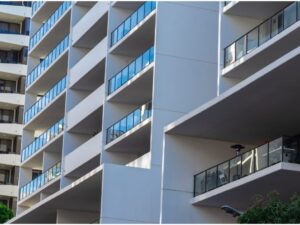
Australia’s housing market increased slightly on average in April and continues to reflect the push/pull of high interest rates and low availability.
Take a look at some figures from around the country.
Australian property market updates
According to CoreLogic’s latest figures, the latest month-on-month rise of 0.6% has added approximately $4,720 to the national median dwelling value. Statistics show that the current growth
cycle is in its 15th month, with housing values up 11.1% since the most recent trough in January last year.
Month on month, every capital city except Melbourne demonstrated an increase in April, although numbers are beginning to flatten in some parts of the country:
• Sydney: 0.4 per cent
• Melbourne: -0.1 per cent
• Brisbane: 0.9 per cent
• Adelaide: 1.3 per cent
• Perth: 2.0 per cent
• Hobart: 0.3 per cent
• Darwin: 0.6 per cent
• Canberra: 0.2 per cent
Year on year, growth figures look like this:
• Sydney: 8.7 per cent
• Melbourne: 2.8 per cent
• Brisbane: 16.1 per cent
• Adelaide: 14.0 per cent
• Perth: 21.1 per cent
• Hobart: -0.4 per cent
• Darwin: 1.9 per cent
• Canberra: 2.1 per cent
Combined regional area growth was recorded at 0.8% in April.
Top performing areas
Across the country, CoreLogic noted the best-performing districts over the last twelve months. These include:
Greater Sydney
• Mount Druitt (14.1% growth)
• Blacktown (13.5% growth)
• Eastern suburbs south (13.3% growth)
Greater Melbourne
• Darebin – North (7.4% growth)
• Moreland – North (6.9% growth)
• Nillumbik – Kinglake (6.9% growth)
Greater Brisbane
• Springwood – Kingston (23.5% growth)
• Forest Lake – Oxley (22.0% growth)
• Sunnybank – (21.6% growth)
Greater Adelaide
• Playford (20.4% growth)
• Prospect – Walkerville (18.7% growth)
• Salisbury (17.3% growth)
Greater Perth
• Armadale (31.6% growth)
• Kwinana (28.6% growth)
• Rockingham (27.9% growth)
Greater Hobart
• Hobart – North East (1.0% growth)
• Brighton (0.7% growth)
• Sorell – Dodges Ferry (0.6% growth)
Greater Darwin
• Darwin City (4.5% growth)
• Palmerston (1.9% growth)
• Litchfield (1.7% growth)
ACT
• South Canberra (4.3% growth)
• Weston Creek (3.5% growth)
• Tuggeranong (3.2% growth)
What is driving the market?
Recent CPI figures surprised some forecasters by coming in ahead of expectations. In Australia, while inflation is easing, year on year CPI figures for March were still slightly higher than expected.
This was partly due to increased rental property prices. According to the Australian Bureau of Statistics, average rental costs increased by 8.5 per cent in capital cities and 5.4 per cent in regional areas between March 2023 and March 2024.
Inflation is a big factor influencing interest rates and the latest CPI results put a dampener on hopes for rate cuts in the near future. As a result, it’s likely Australia’s property prices will not take off
dramatically in the near future.
However, as mentioned, the lack of supply is keeping prices buoyant. As the rental market has demonstrated, the reduction in available properties continues to push prices skyward and keep
vacancy rates low.
The good news about current home values in Australia is that we are not going backwards. If you’re looking to sell, auction clearance rates are still strong and there are plenty of active buyers out there.
Meanwhile, if you’re buying or investing, the relatively stable nature of property prices should give you more confidence about what you will get for your money.
Looking to buy or sell in 2024? Reach out at teresa@teresaberger.com.au.




